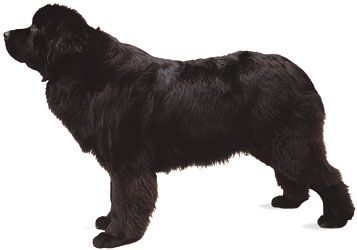Newfoundland
breed of dog
 breed of working dog developed in Newfoundland, possibly from crosses between native dogs and the Great Pyrenees dogs taken to North America by Basque fishermen in the 17th century. Noted for rescuing persons from the sea, the Newfoundland is a huge, characteristically gentle and patient dog standing 26 to 28 inches (66 to 71 cm) and weighing 100 to 150 pounds (45 to 68 kg). Powerful hindquarters, a large lung capacity, large webbed feet, and a heavy, oily coat contribute to the dog's ability to swim and to withstand cold waters. In addition to performing rescue work, the Newfoundland has served as a watchdog and companion and as a draft animal. The typical Newfoundland is solid black, brown, or gray; the Landseer Newfoundland, named for Sir Edwin Landseer (Landseer, Sir Edwin), the artist who painted it, is usually black and white.
breed of working dog developed in Newfoundland, possibly from crosses between native dogs and the Great Pyrenees dogs taken to North America by Basque fishermen in the 17th century. Noted for rescuing persons from the sea, the Newfoundland is a huge, characteristically gentle and patient dog standing 26 to 28 inches (66 to 71 cm) and weighing 100 to 150 pounds (45 to 68 kg). Powerful hindquarters, a large lung capacity, large webbed feet, and a heavy, oily coat contribute to the dog's ability to swim and to withstand cold waters. In addition to performing rescue work, the Newfoundland has served as a watchdog and companion and as a draft animal. The typical Newfoundland is solid black, brown, or gray; the Landseer Newfoundland, named for Sir Edwin Landseer (Landseer, Sir Edwin), the artist who painted it, is usually black and white.- Ruwenzori Range
- Ruy González de Clavijo
- Ruy López de Segura
- Ruysbroeck, Jan van
- Ruysch, Rachel
- Ruysdael, Salomon van
- Ružička, Leopold
- R. Walter Cunningham
- Rwanda
- Rwanda, flag of
- Rwanda language
- R. William Jones
- R.W. Sears
- Ryabushinsky Family
- Ryan, Nolan
- Ryan, T. Claude
- Ryan, Thomas Fortune
- rya rug
- Ryazan
- Rybakov, Anatoly
- Rybinsk
- Rybinsk Reservoir
- Rybnik
- Ry Cooder
- Rydberg constant